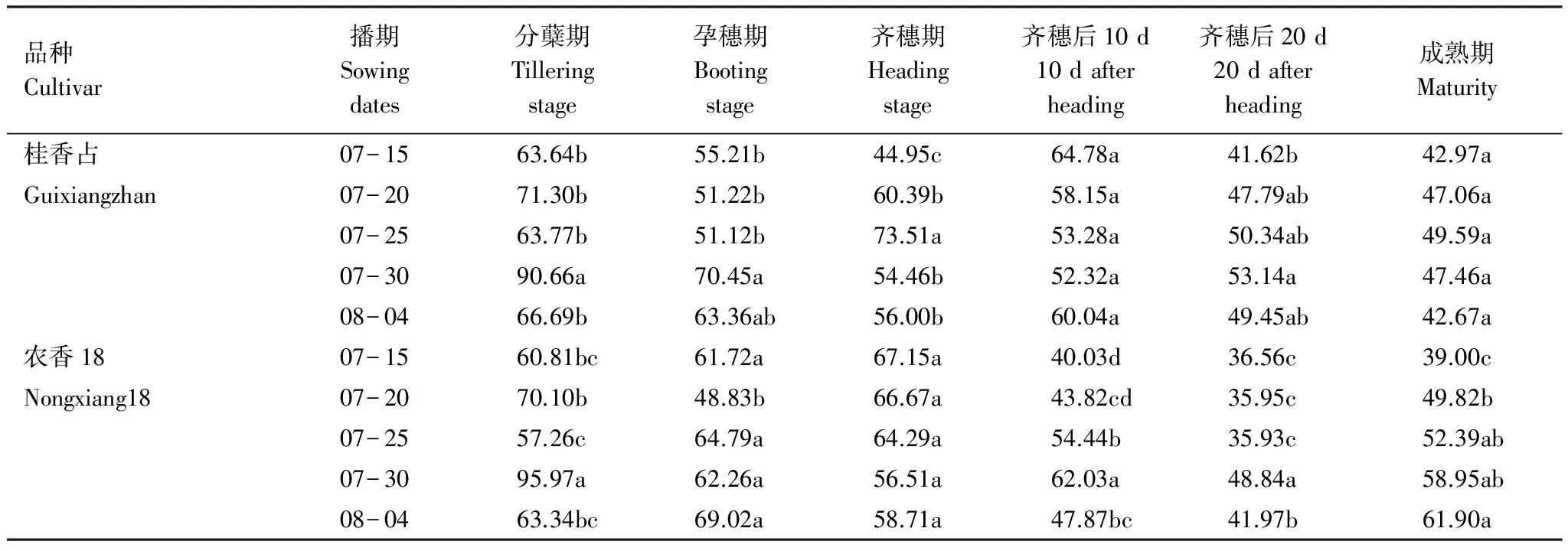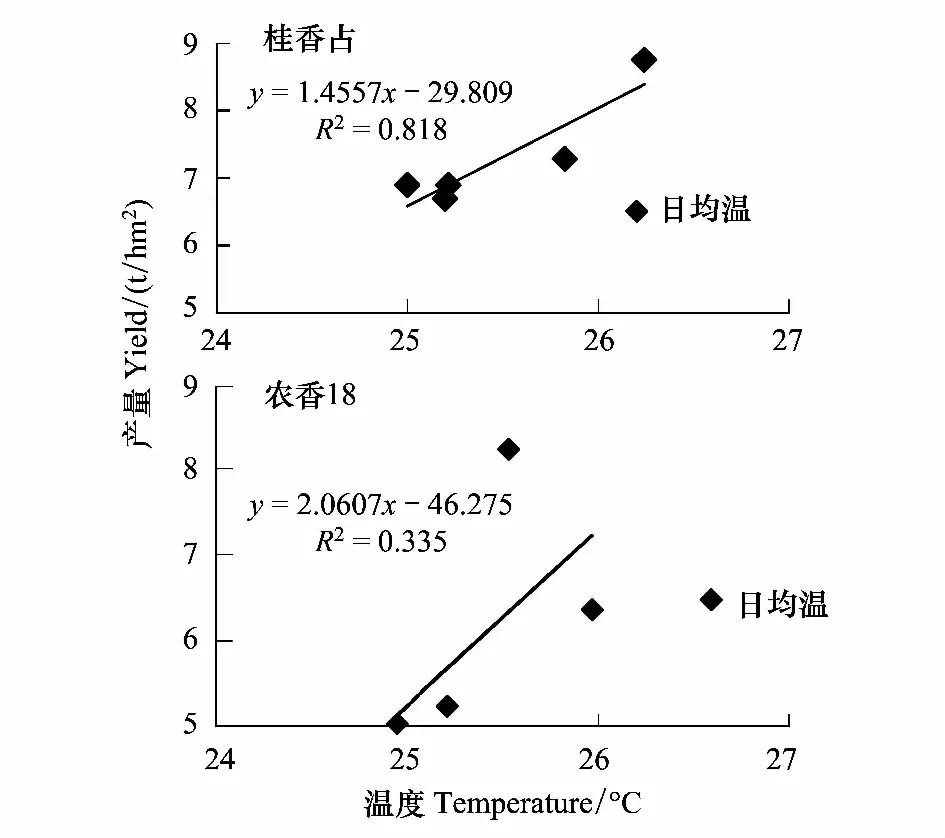播种期对晚季香稻香气2-乙酰-1-吡咯啉含量和产量的影响
2014-08-11杨晓娟唐湘如闻祥成李艳红周新建
杨晓娟, 唐湘如,*, 闻祥成, 李艳红, 周新建
(1. 华南农业大学农学院, 广州 510642; 2. 农业部华南地区作物栽培科学观测实验站, 广州 510642 )
播种期对晚季香稻香气2-乙酰-1-吡咯啉含量和产量的影响
杨晓娟1,2, 唐湘如1,2,*, 闻祥成1,2, 李艳红1,2, 周新建1
(1. 华南农业大学农学院, 广州 510642; 2. 农业部华南地区作物栽培科学观测实验站, 广州 510642 )
为了确定华南双季稻区晚季香稻的适宜播种期,在大田条件下以桂香占和农香18为材料,研究了播种期对香稻香气2-乙酰-1-吡咯啉(2-AP)、脯氨酸代谢酶活性和产量的影响。结果表明:(1)7月20日播种的香稻的2-AP含量最高,2-AP含量较高的播期其游离脯氨酸含量、籽粒脯氨酸氧化酶活性以及脯氨酸脱氢酶活性维持在较高水平。(2)7月15日播种的桂香占和7月20日播种的农香18的产量最高,产量较高的播期具有较高的收获指数、干物质积累量和群体生长率。(3)试验条件下晚季香稻的适宜播种期为7月15日—7月20日。
香稻;播期;2-乙酰-1-吡咯啉;产量
水稻产量和品质的形成除了受遗传控制外,还受气候因子、生态环境和栽培措施等外界因素的影响,气候因子中温度和光照是影响产量和品质形成的重要因子[1]。不同播期的水稻由于生育进程不同,对温光资源的利用情况发生改变,导致产量的差异[2- 3]。姚义等研究表明推迟播种降低了水稻的每穗颖花数和结实率,导致产量的显著下降[4]。推迟播期会使抽穗期后延,灌浆期的日平均温度和有效积温下降,影响籽粒的灌浆速度和时间,造成籽粒充实度差,空瘪粒数增加,实粒数减少和千粒重下降[5]。沈庆雷等研究表明推迟播种会使穗粒数下降导致产量下降[6]。也有研究表明针对不同的水稻品种,适当推迟播种期是有利的[7]。香稻的糙米香气是香稻品质的重要指标,其主要成分是是2-乙酰-1-吡咯啉(2-acety-1-pyrroline,简称2-AP)[8- 10],其形成与积累除了受遗传因素影响外,还与栽培过程中的施肥、气候条件等密切相关。各气象因子中以光温条件影响稻米香味品质显著[11],已有研究表明成熟时期的低温有利于香稻快速形成香气化合物[12],但不同播期对香稻香气形成的影响鲜有报道。为此,本试验以香稻桂香占和农香18为材料,通过分期播种的方法,探讨不同播种期对香稻香气形成和产量的影响规律,确定晚季香稻的适宜播种期,为香稻的优质浓香栽培提供理论依据和技术指导。
1 材料与方法
1.1 供试材料与条件
供试水稻品种为常规香稻桂香占、农香18。
试验于2012年晚季在广州华南农业大学农学院试验基地(23°09′N,113°22′E,海拔高度11 m)进行,前茬作物为早稻。土壤为砂壤土,耕作层有机质含量19.65 g/kg、全氮0.971 g/kg、全磷0.821 g/kg、全钾25.504 mg/kg、碱解氮106.55 mg/kg、速效钾189.48 mg/kg、有效磷31.74 mg/kg、有效硼0.562 mg/kg,土壤pH值 5.44。香稻在不同播期下的气象条件见表1。
1.2 试验设计
试验采用完全随机区组设计,分别于 7 月 15 日(07- 15)、7 月 20 日(07- 20)、7 月25日(07- 25)、7 月30 日(07- 30)和 8 月4 日(08- 04)进行播种。秧田期16 d,株行距 20 cm×20 cm,每穴2苗移栽。小区面积30 m2,每个播期设置3个重复。

表1 不同播期下的气象条件
1.3 测定指标及方法
1.3.1 糙米香气(2-AP)、游离脯氨酸、脯氨酸氧化酶参考黄忠林等[13]的方法。
1.3.2 脯氨酸脱氢酶
参考赵贵林等[14]的方法。
1.3.3 数据处理
使用Excel 2007 和SPSS 17.0进行作图和数据分析。
2 结果与分析
2.1 播期对晚季香稻糙米香气的影响

图1 播期对糙米2-AP含量的影响Fig.1 Effects of sowing dates on 2-AP content of brown rice
图1表明,不同播期对香稻糙米2-AP含量的影响呈现出品种差异。桂香占07- 20处理的2-AP含量最高,达到51.18 ng/g,桂香占各处理下2-AP含量表现为07- 20>08- 04>07- 30>07- 15>07- 25。农香18在07- 20处理的2-AP含量最高,达到94.33 ng/g,农香18各处理下2-AP含量表现为07- 20>07- 15>07- 25>07- 30>08- 04。
2.2 播期对晚季香稻香气形成生理特性的影响
2.2.1 播期对香稻游离脯氨酸的影响
表2表明,07- 30处理的桂香占最上叶游离脯氨酸含量在分蘖期、孕穗期齐穗后20 d高于其他处理,07- 25处理的桂香占最上叶游离脯氨酸含量在齐穗期和成熟期高于其他处理。07- 30处理的农香18在分蘖期、齐穗后10 d和齐穗后20 d显著高于其他处理,08- 04处理的农香18在孕穗期和成熟期高于其他处理。
表3表明,桂香占籽粒游离脯氨酸含量随生育期的推移呈先下降后上升趋势,07- 30处理齐穗后10 d、齐穗后20 d高于或显著高于其他处理,08- 04处理成熟期显著高于其他处理。农香18 07- 30处理籽粒游离脯氨酸含量随生育期的推移先下降后上升,而其余各处理则呈上升趋势,07- 30处理齐穗后10 d显著高于其他处理,齐穗后20 d和成熟期各处理之间差异不显著。
2.2.2 播期对香稻脯氨酸氧化酶的影响
表4表明,桂香占和农香18各处理间的最上叶的脯氨酸氧化酶活性在分蘖期、孕穗期和齐穗后10 d前差异均不显著, 07- 20处理的农香18最上叶脯氨酸氧化酶活性在成熟期显著高于其他处理。

表2 播期对最上叶游离脯氨酸含量(U/g)的影响
同列数据后标不同小写字母表示差异显著(P<0.05,LSD检验)

表3 播期对香稻籽粒游离脯氨酸含量(U/g)的影响

表4 播期对香稻最上叶脯氨酸氧化酶活性的影响
表5表明,桂香占和农香18籽粒脯氨酸氧化酶的OD值随生育期的推移呈低幅上升趋势。桂香占08- 04处理齐穗后10 d,07- 15处理齐穗后20 d显著高于其他处理,成熟期籽粒脯氨酸氧化酶的OD值以07- 20处理最高。农香18 成熟期籽粒脯氨酸氧化酶的OD值以07- 15处理最高,齐穗后10 d和齐穗后20 d各处理间的差异并不显著。

表5 播期对香稻籽粒脯氨酸氧化酶活性的影响
2.2.3 播期对香稻脯氨酸脱氢酶的影响
表6表明,桂香占和农香18最上叶脯氨酸脱氢酶活性随生育期的推移呈曲线上升趋势。桂香占07- 15处理分蘖期、齐穗后10 d和齐穗后20 d最上叶脯氨酸脱氢酶活性高于或显著高于其他处理,08- 04处理齐穗期和07- 30处理成熟期最上叶脯氨酸脱氢酶活性显著高于其他处理。农香18在07- 20处理分蘖期和齐穗后10 d最上叶脯氨酸脱氢酶活性显著高于其他处理,08- 04处理齐穗期和齐穗后20 d最上叶脯氨酸脱氢酶活性显著高于其他处理,07- 15处理孕穗期和07- 20处理成熟期最上叶脯氨酸脱氢酶活性显著高于其他处理。

表6 播期对香稻最上叶脯氨酸脱氢酶活性(U·g-1·min-1)的影响
表7表明,桂香占和农香18籽粒脯氨酸脱氢酶活性随生育期的推移呈上升趋势。桂香占07- 30处理齐穗后10 d,07- 15处理齐穗后20 d和成熟期籽粒脯氨酸脱氢酶显著高于其他处理。农香18在08- 04处理齐穗后10 d,07- 25处理齐穗后20 d和成熟期籽粒脯氨酸脱氢酶显著高于其他处理。
2.3 播期对产量及其构成因素的影响
表8表明,随着播期的推迟,两个香稻品种的产量呈不同程度的下降。桂香占07- 15处理由于结实率的显著优势使得其产量高于或显著高于其他处理;农香18在07- 20处理由于结实率的显著优势使得其产量显著高于其他处理,07- 30处理由于气象条件等的不可控因素使得其结实率显著低于其他处理。播期对有效穗和穗粒数的影响呈现品种差异,桂香占08- 04处理的有效穗高于或显著高于其他处理,桂香占07- 30处理的穗粒数高于或显著高于其他处理,而农香18各处理间的有效穗和穗粒数均无显著差异。就千粒重而言,两个品种均是07- 25处理最高。

表7 播期对香稻籽粒脯氨酸脱氢酶活性(U·g-1·min-1)的影响

表8 不同播期的香稻产量及其构成因素
2.4 播期对地上部干物质积累和收获指数的影响
表9表明,不同播期香稻的地上部干物质积累随着生育进程的推移而上升。桂香占和农香18在07- 25处理分蘖期、07- 30处理齐穗期的地上部干物质积累显著高于其他处理。桂香占07- 20处理成熟期高于或显著高于其他处理,农香18在07- 15处理高于或显著高于其他处理。桂香占07- 25处理的收获指数显著高于其他处理,农香18在07- 20处理的收获指数显著高于其他处理。
2.5 播期对香稻群体生长率(CGR)的影响
群体生长率是描述群体生长的重要指标,主要反映单位面积上群体生长速度。图2表明,桂香占和农香18各播期处理的CGR从分蘖期到齐穗期持续升高,其中以齐穗期最高,齐穗后CGR急剧下降。
2.6 播期对生育期及积温的影响
表10表明,香稻的生育期随着播种期的推迟呈延长趋势,桂香占的全生育期延迟1—29 d,农香18的全生育期延迟0—23 d。随着播种期的推迟,桂香占和农香18生育期间大于10 ℃的积温呈先下降后上升的趋势。

表9 不同播期香稻地上部干物质积累(t/hm2)和收获指数

图2 播期对香稻群体生长率的影响Fig.2 Effects of sowing dates on Crop growth rate (CGR) of aromatic rice

品种Cultivar播期Sowing移栽Transplant分蘖Tillering孕穗Booting抽穗Heading齐穗Fullheading成熟Maturity全生育期Wholegrowthperoid/d>10℃积温accumulatedtemperature/℃桂香占Guixinagzhan07-1508-0208-2309-2109-2509-2810-261042728.9007-2008-0709-0109-2810-0310-0611-011052711.5007-2508-1209-0710-0310-0610-0811-121102798.7007-3008-1809-1810-1610-2510-2812-091333135.1008-0408-2209-1810-1610-2710-3012-091282989.20农香18Nongxiang1807-1508-0208-2309-2309-2509-2811-011102856.6007-2008-0709-0109-2810-0610-0811-071102833.6007-2508-1209-0710-0310-0810-1211-121102798.7007-3008-1809-1810-1610-2710-3012-091333135.1008-0408-2209-1810-1610-2911-0112-091282989.20
2.7 播期生育期内产量与平均气温的关系
图3表明,不同播期的产量随着生育期间日平均气温的升高而上升,但存在一定的品种差异,桂香占和农香18产量与平均气温的相关系数分别为0.818和0.335。

图3 日平均气温与产量的关系Fig.3 Relation to average daily temperature and yield
3 结论与讨论
不同播期对香稻糙米2-AP含量的影响呈品种差异。研究表明成熟时期的低温有利于香稻快速形成香气化合物[12],Shantha N等研究表明夜间温度从22 ℃升至26 ℃时,香稻的香气含量从中等水平下降到较低水平[15]。本试验中,适当推迟播种提高了香稻糙米的香气物质2-AP含量。桂香占和农香18均以7月20日播种处理糙米的2-AP含量最高,其成熟期的平均气温分别为22.6 ℃和22.0 ℃。其后的各个播期由于成熟期平均气温的下降,香稻糙米的2-AP含量呈不同幅度的下降,表明成熟期平均气温在22—23 ℃有利于2-AP的合成和积累。脯氨酸是2-AP的氮源前体,唐湘如等研究表明,齐穗后期籽粒的脯氨酸需求增加,从剑叶调运出的脯氨酸亦增加,导致残留在剑叶中的脯氨酸含量下降[16]。本试验中,随着生育进程的推移,香稻最上叶游离脯氨酸含量呈下降趋势,生育后期由于脯氨酸转运加快使得籽粒游离脯氨酸含量呈上升趋势。脯氨酸氧化酶是香稻香气形成的关键酶,脯氨酸氧化酶活性的提高有利于促进籽粒2-AP的合成与积累[17]。本试验中,随着生育进程的推移,香稻最上叶脯氨酸氧化酶和籽粒脯氨酸氧化酶活性呈低幅上升趋势。不同播期对香稻脯氨酸氧化酶活性的影响并不十分显著,但香气含量较高的播期其脯氨酸氧化酶活性维持在较高水平,有利于提高其糙米香气含量。脯氨酸脱氢酶活性增加,有利于促进脯氨酸的转化[14]。随着生育进程的推移,香稻最上叶脯氨酸脱氢酶和籽粒脯氨酸脱氢酶活性呈上升趋势,香气含量较高的播期其籽粒脯氨酸氧化酶活性维持在较高水平。
我国是水稻生产大国,水稻种植区域的生态条件存在较大差异。关于播期对水稻生长发育及产量形成的影响,研究结果也不尽相同[18- 19]。本试验中,桂香占在7月15日播种的处理产量最高,收获指数高于或显著高于其他处理;农香18在7月20日播种产量最高,收获指数显著高于其他处理。由于播种时间的推迟,灌浆结实期的平均气温下降,影响了籽粒的灌浆速率降低了水稻的结实率。推迟播种在一定程度上降低了两个品种的产量,但两个品种的产量降幅不大一致。就千粒重而言,7月25日播种的千粒重显著高于其他处理。杨慧杰等研究认为高产水稻前期的群体生长率较低,中期最高,后期次高[20],本试验中产量较高的播期生长中、后期均具有较高的群体生长率,使其后期具有干物质积累的优势。产量对生育期内平均气温的响应呈现出品种差异,桂香占产量与平均气温的相关系数较农香18的大。
在水稻生产实践中,应注意针对不同的稻作区的气候条件选择适宜的播种期。华南双季稻区晚季香稻的适宜播种期为7月15日—7月20日,可获得高产和高香气物质2-AP含量。
[1] Rao G S,XIAO L Z,GAN M M,Tian J Y,Du Y D,Chen X G,Tang X R. Study on rice optimum sowing date in Guangdong under climatic warming. Chinese Agricultural Science Bulletin, 2012,28(5):300- 305.
[2] Deng F,WANG L,LIU L, Liu D Y,Ren W J,Yang W Y. Effects of cultivation methods on dry matter production and yield of rice under different ecological conditions.Acta Agronomica Sinica, 2012,38(10):1930- 1942.
[3] Huo Z Y,Yao Y,Zhang H C,Xia Y,Ni X C,Dai Q Y,Xu K,Wei H Y. Effect of sowing date on characteristics of photosynthesis and matter production of direct seeding Rice. Scientia Agricultura Sinica, 2012,45(13):2592- 2606.
[4] Yao Y,Huo Z Y, Zhang H C, Xia Y,Ni X C,Dai Q Y,Xu K,Wei H Y. Effects of sowing date on growth stage and utilization of temperature and illumination of direct seeding rice in different ecological regions. Scientia Agricultura Sinica, 2012,45(4):633- 647.
[5] Yao Y,Huo Z Y, Zhang H C,Xia Y,Ni X C,Dai Q G,Xu K,Wei H Y,Xiao Y C,Wang X.Effects of sowing date on yield and quality of direct seeding rice of different types and varieties. Scientia Agricultura Sinica, 2011,44(15):3098- 3107.
[6] Shen Q L,He W Z,Zhao T F,Wang L E,Cao X L,Zhang P,Gu Y L,Du B,Yuan X M. Effects of sowing dates on agronomic characters and yield of direct-seeding rice. Shanghai Agricultural Science and Technology, 2012(5):53- 54.
[7] Li J G,Han Y,Xie W X,Liu B,Jiang X Y,Gao Q,Wang L. Effects of the temperature and humidity in filling and fruiting stages on the yield and quality of rice. Journal of Anhui Agri. Sci., 2008,36(8):3160- 3162.
[8] Bryant R J, Mcclung A M. Volatile profiles of aromatic and non-aromatic rice cultivars using SPME/GC-MS. Food Chemistry, 2011,124(2):501- 513.
[9] Grimm C C, Champagne E T, Lloyd S W, Easson M,Condon B,McClung A. Analysis of 2-Acetyl-1-pyrroline in rice by HSSE/GC/MS. Cereal Chemistry, 2011,88(3):271- 277.
[10] Vanavichit A, Yoshihashi T. Molecular aspects of fragrance and aroma in Rice. Advances in Botanical Research, 2010,56:49- 73.
[11] Zhao Z P,Li G,Wu S J,Lu J A. Progress of study on aromatic rice. Acta Agriculturae Shanghai,2009,25(2): 110- 114.
[12] Tomio I, Masahiko T,Yasuyoshi H,Fushimi T,Hashizume K. Variation of 2-Acetyl-1-Pyrroline concentration in aromatic rice grains collected in the same region in Japan and factors affecting its concentration. Plant Production Science, 2004,7(2):178- 183.
[13] Huang Z L, Tang X R, Wang Y L, Chen M J,Zhao Z K,Duan M Y,Pan S G. Effects of increasing aroma cultivation on aroma and grain yield of aromatic rice and their mechanism. Scientia Agricultura Sinica, 2012(6):1054- 1065.
[14] Zhao G L,Chen Q,Hu G X, Zhu Y,Ma L J,Li X M. Responses of the key enzymes involved in proline metabolism in rice seedling under water stress.Agricultural Research in the Arid Areas, 2011,29(3):80- 83.
[15] Nagarajan S,Jagadish SVK,Prasad ASH,Thomar AK,Anand A,Pal M,Agarwal PK. Local climate affects growth, yield and grain quality of aromatic and non-aromatic rice in northwestern India. Agriculture, Ecosystems and Environment,2010,138(3/4):274- 281.
[16] Tang X R,Wu M.Effects of application of Zinc,Iron and Lanthanum on contents of aroma in brown rice and proline in flag leaf of aromatic rice. Hybrid Rice, 2006(6):69- 72.
[17] Duan M Y,Li G X,Tian H,Zhong K Y,Tang X R.Primary research on the physiological characteristics of aroma formation in aromatic rice. Journal of Hunan Agricultural University: ( Natural Sciences ), 2009,35(1):5- 8.
[18] Yao Y,HUO Z Y,ZHANG H C, Xia Y, Ni X C, Dai Q G, Xu K, Wei H Y. Effects of sowing date on the growth characteristics of direct seeding rice. Chinese Journal of Ecology,2010,29(11): 2131- 2138.
[19] Bashir M U,Akbar N,Iqbal A, Zaman H.Effect of different sowing dates on yield and yield components of direct seeded coarse rice (OryzasativaL).Pakistan Journal of Agricultural Science,2010,47(4):361- 365.
[20] Yang H J,Li Y Z,Yang R C,Jiang Z W,Zheng J S. Dry matter production characteristics of super high yielding rice.Chinese Journal of Rice Science,2001,15(4):265- 270.
参考文献:
[1] 饶刚顺,肖立中,甘海梅,田晋元,杜尧东,陈新光,唐湘如.气候变暖情况下广东水稻最适播种期初探. 中国农学通报,2012,28(5):300- 305.
[2] 邓飞,王丽,刘利,刘代银,任万军,杨文钰.不同生态条件下栽培方式对水稻干物质生产和产量的影响. 作物学报,2012,38(10):1930- 1942.
[3] 霍中洋, 姚义, 张洪程,夏炎,倪晓诚,戴其根,许轲,魏海燕. 播期对直播稻光合物质生产特征的影响. 中国农业科学, 2012,45(13):2592- 2606.
[4] 姚义,霍中洋,张洪程,夏炎,倪晓诚,戴其根,许轲,魏海燕. 不同生态区播期对直播稻生育期及温光利用的影响. 中国农业科学, 2012,45(4):633- 647.
[5] 姚义,霍中洋,张洪程,夏炎,倪晓诚,戴其根,许轲,魏海燕,肖跃成,王显.播期对麦茬直播粳稻产量及品质的影响. 中国农业科学, 2011,44(15):3098- 3107.
[6] 沈庆雷,何为志,赵田芬,王联恩,曹晓利,张平,顾玉龙,杜斌,袁晓明. 不同播期对直播水稻农艺性状及产量的影响.上海农业科技,2012(5):53- 54.
[7] 李建国,韩勇,解文孝,刘博,姜秀英,高岐,王丽. 播期及环境因子对水稻产量和品质的影响. 安徽农业科学, 2008,36(8):3160- 3162.
[11] 赵志鹏,李刚,吴书俊,陆家安. 香稻研究进展. 上海农业学报,2009,25(2): 110- 114.
[13] 黄忠林,唐湘如,王玉良,陈慕娇,赵正琨,段美洋,潘圣刚.增香栽培对香稻香气和产量的影响及其相关生理机制. 中国农业科学, 2012(6):1054- 1065.
[14] 赵贵林,陈强,胡国霞,褚妍,马莲菊,李雪梅. 水稻脯氨酸代谢关键酶对水分胁迫的响应. 干旱地区农业研究,2011,29(3):80- 83.
[16] 唐湘如,吴密. 施用锌、铁、镧肥对香稻糙米香气和剑叶脯氨酸含量的影响. 杂交水稻, 2006,21(6):69- 72.
[17] 段美洋,黎国喜,田华,钟克友,唐湘如.香稻香气形成的生理特性初步研究. 湖南农业大学学报( 自然科学版 ), 2009,35(1):5- 8.
[20] 杨惠杰,李义珍,杨仁崔,姜照伟,郑景生. 超高产水稻的干物质生产特性研究. 中国水稻科学,2001, 15(4):265- 270.
Effects of sowing date on 2-acetyl-1-pyrroline content and yield of late season aromatic rice
YANG Xiaojuan1,2,TANG Xiangru1,2,*,WEN Xiangcheng1,2,LI Yanhong1,2,ZHOU Xinjian1
1CollegeofAgriculture,SouthChinaAgriculturalUniversity,Guangzhou510642,China2ScientificObservingandExperimentalStationofCropcultivationinSouthChina,MinistryofAgriculture,Guangzhou510642,China
Aromatic rice, a famous rice type with high nutritional value and a distinct aroma, has been planted in South and Southeast Asian countries since ancient times. Recently, it has gained in popularity and gained a significant market share in the global rice trade resulting in higher prices and increased production in many countries. However, in China, a minimal area has been planted with aromatic rice because of its low resistance to disease, low yield and other disadvantages of the aromatic rice cultivars. As the standard of living has improved, China has begun to focus on the production of quality food, so researchers have started to pay more attention to aromatic rice and have bred some aromatic rice cultivars. However, finding ways to increase the concentration of the aroma of aromatic rice has proved challenging based on the low yield and poor quality of existing cultivars. 2-Acetyl-1-pyrroline (2-AP) is a buttered-popcorn-like aromatic compound found in both basmati and jasmine aromatic rice, and is considered a primary aromatic component of aromatic rice; this highly volatile and lipophilic compound occurs in the stems, leaves and grains of aromatic rice. L-proline is widely considered to be the nitrogen source for 2-AP and Δ-pyrroline-5-carboxylic acid (P5C) and has been proposed as one of the main precursors required for 2-AP synthesis. P5C is the common intermediate in the metabolic pathways of proline, ornithine and glutamic acid synthesis. Among these three pathways, the proline pathway is the major pathway used for the synthesis of 2-AP, in which proline to P5C is mediated by proline dehydrogenase, which is then used to synthetize 2-AP. Genetic factors play a major role in determining the aroma content of aromatic rice, and environmental factors and cultivation practices have a substantial effect on the quality of aromatic rice. The aroma of aromatic rice can be increased using low-density cultivation techniques, shallow irrigation, low levels of nitrogen, and moderate use of trace element fertilizers containing elements such as zinc, iron and lanthanum. However, unsuitable post-harvest conditions and some plant growth regulators can reduce the 2-AP content in aromatic rice considerably. Using better packaging materials, such as vacuum packing in nylon pouches, can retard volatilization of the aromatic compounds in aromatic rice. Temperature during grain filling, ripening and storage also plays an important role in the development of the aroma of aromatic rice; lower temperature, especially at night, has positive effects on aroma formation during the grain filling and ripening stages compared with higher temperature. Additionally, 2-AP content declines over time and is significantly affected by the temperature during storage. The sowing date affects proline and 2-AP content in aromatic rice as a result of variations in light and temperature conditions. Hence, a field experiment was carried out using Guixiangzhan and Nongxiang18 cultivars to determine an appropriate sowing date for late season aromatic rice in South China′s double-cropping region and to study the effects of different sowing dates on aroma (2-AP), activities of proline metabolic enzymes and yield. The results show (1) Aromatic rice sown on 20 July achieved the highest 2-AP content. Treatments having higher 2-AP content also had a higher free proline content, higher proline oxidase activities in grain and higher levels of proline dehydrogenase. (2) Guixiangzhan sown on 15 July and Nongxiang18 sown on 20 July achieved the highest grain yield, and both had a high harvest index, high levels of dry matter accumulation and rapid crop growth rates. (3) The appropriate late season sowing date for aromatic rice was between 15 July and 20 July.
aromatic rice;sowing dates; 2-acetyl-1-pyrroline;yield
国家自然科学基金项目(31271646);广东省自然科学基金项目(8151064201000017);广东省农业攻关项目(2011AO20202001) ;广东省农业标准化项目(4100F10003)
2013- 05- 21;
2013- 10- 11
10.5846/stxb201305211129
*通讯作者Corresponding author.E-mail: tangxr@scau.edu.cn
杨晓娟, 唐湘如, 闻祥成, 李艳红, 周新建.播种期对晚季香稻香气2-乙酰-1-吡咯啉含量和产量的影响.生态学报,2014,34(5):1156- 1164.
Yang X J,Tang X R,Wen X C,Li Y H,Zhou X J.Effects of sowing date on 2-acetyl-1-pyrroline content and yield of late season aromatic rice.Acta Ecologica Sinica,2014,34(5):1156- 1164.
